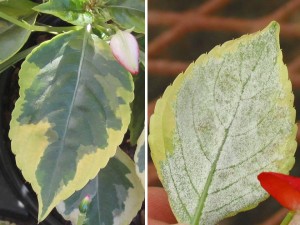In 2011 across Europe, seventy percent (70%) of the garden impatiens (Impatiens walleriana) were hit with downy mildew. Disease outbreaks were also reported in a few U.S. coastal cities last year. U.S. growers have been preparing for the possible outbreak in summer 2012. The potential for this disease can be catastrophic as the fungus can overwinter in the soil.
Gardeners should purchase disease-free plants at garden shops this spring. They should inspect plants closely, and don’t buy those with yellowed or misformed leaves. They should not plant where impatiens were growing last summer. If other annuals, say snapdragons or zinnias, were infected last year, this form of downy mildew will not effect impatiens.
At this time downy mildew appears to be limited to seed-produced impatiens. Vegetatively-produced impatiens (from cuttings or tissue culture) appear to be clean. Some kinds of impatiens are not susceptible to downy mildew, such as SunPatiens and New Guinea impatiens.
Downy mildew is a systemic pathogen. Symptoms include a downy white coating on the underside of the leaves. Defoliation soon follows. Other clues include leaf stippling, chlorosis (yellowing), and downward curling of leaf margins. If plants become infected, there is no pesticide spray option available. Dig up and discard all contaminated impatiens immediately and never compost the diseased plants.
Permit me to offer a calming statement. If you are planning to or have already planted impatiens this year, enjoy the colorful array which impatiens do provide. U.S. greenhouse growers have been aware of the problem for almost a year and plants for sale should be disease-free. Stay informed about this disease.


 Posted in
Posted in 
